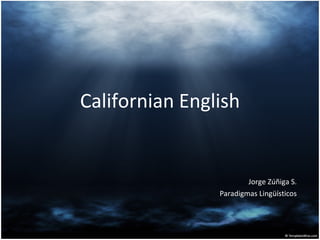
Californian english
- 1. Californian English Jorge Zúñiga S. Paradigmas Lingüísticos
- 2. Geographical situation of the State of California
- 3. History California Gold Rush -People from Canada and the rest of the United States There was a huge internal movement especially from New England and the Midwest Illinois, Indiana, Iowa, Kansas, Michigan, Minnesota, Missouri, Nebraska and North Dakota.
- 4. Phonology -As a variety of American English it is a rhotic accent. - Notable is the absence of /ɔ/, which has merged with /ɑ/ through the cot-caught merger, and the relatively open quality of /ɪ/ due to the California vowel shift. -The vowels in words such as Mary, marry, merry are merger to [ɛ]. -There is a vowel shift in Californian English.
- 5. California vowel shift according to Eckert
- 6. Some other phonological features: Two phonemes, /ɪ/ and /æ/, have allophones that are fairly widely spread apart from each other: before /ŋ/, /ɪ/ is raised to [i] /æ/ is raised and diphthongized to [eə] or [ɪə] before nasal consonants; before /ŋ/ it may be identified with the phoneme /e/. /æ/ is lowered in the direction of [a]. The other parts of the chain shift are apparently context-free: /ʊ/ is moving towards [ʌ], /ʌ/ towards [ɛ], /ɛ/ toward [æ], /ɑ/ toward [ɔ], and /u/ and /oʊ/ are diphthongs whose nuclei are moving toward [i] and [e] respectively.
- 7. A remarkable accentual feature: Valspeak Valley Girl (or Val , Val Gal ) is a stereotype leveled at a socio-economic and ethnic class of American women who can be described as: Colloquial English-speaking Materialistic Self-centered Hedonistic It is thought to come from San Fernando Valley
- 8. Valspeak features: It is the most famous Sociolect of Californian English It became common across the United States during the 1980s and 1990s, and much entered teenage slang throughout the country. Qualifiers such as “like” , “whatever” , “way” , “as if!” , “totally” and “duh” were interjected in the middle of phrases and sentences as emphasizers. Narrative sentences were often spoken as though they were questions using a high rising terminal (uptalk) Valspeak is often spoken with a heavy accent sometimes associated with Californians. Words are spoken with high variation in pitch combined with very open or nasal vowel sounds.
- 9. Examples: Like - Used as an interjection. " that was so, like, oh my God." As if – literally "yeah, right" or "as if" except it does not use a subject; expresses disbelief. Bitchin' - adj. slang for excellent; first-rate. Though a derivative of "bitch", bitchin' is sometimes not considered profane. Whatever! - short for "whatever you say"; sarcastic interjection often emphasizing the "r". Fer shur – lit. "For sure" Totally – "I agree" or "completely."
- 10. Some other examples: Oh my God – can be used many ways; expresses shock. Tre - A synonym for "very" (derived from French "très") So - Very; used frequently and said with strong emphasis. Seriously - Frequent interjection of approval. Gnarly - expression of seriousness. can be a word for very intense or very pleasing Are you serious? - expression of surprise.
- 11. Other factors to consider regarding Californian English The Spanish Culture influence from Mexico (Chicano English)
- 12. Other factors to consider regarding Californian English Asian Americans adoption of new words (hapa instead of “half” from Hawaiian to refer to people born in the States but parents from abroad) Vietnam and Taiwan cultural influence on food names mainly.
- 14. References English Intonation. An Introduction J. C. Wells -Uptalk page 37 (2.9) http://www.ehow.com/how_2041258_talk-like-valley-girl.html http://en.wikipedia.org/wiki/California_English http://en.wikipedia.org/wiki/California http://www.youtube.com/watch?v=FITRuXY2o6o http://www.youtube.com/watch?v=mwO08g4vebg&feature=related http://www.stanford.edu/~eckert/vowels.html
- 15. Title The end
